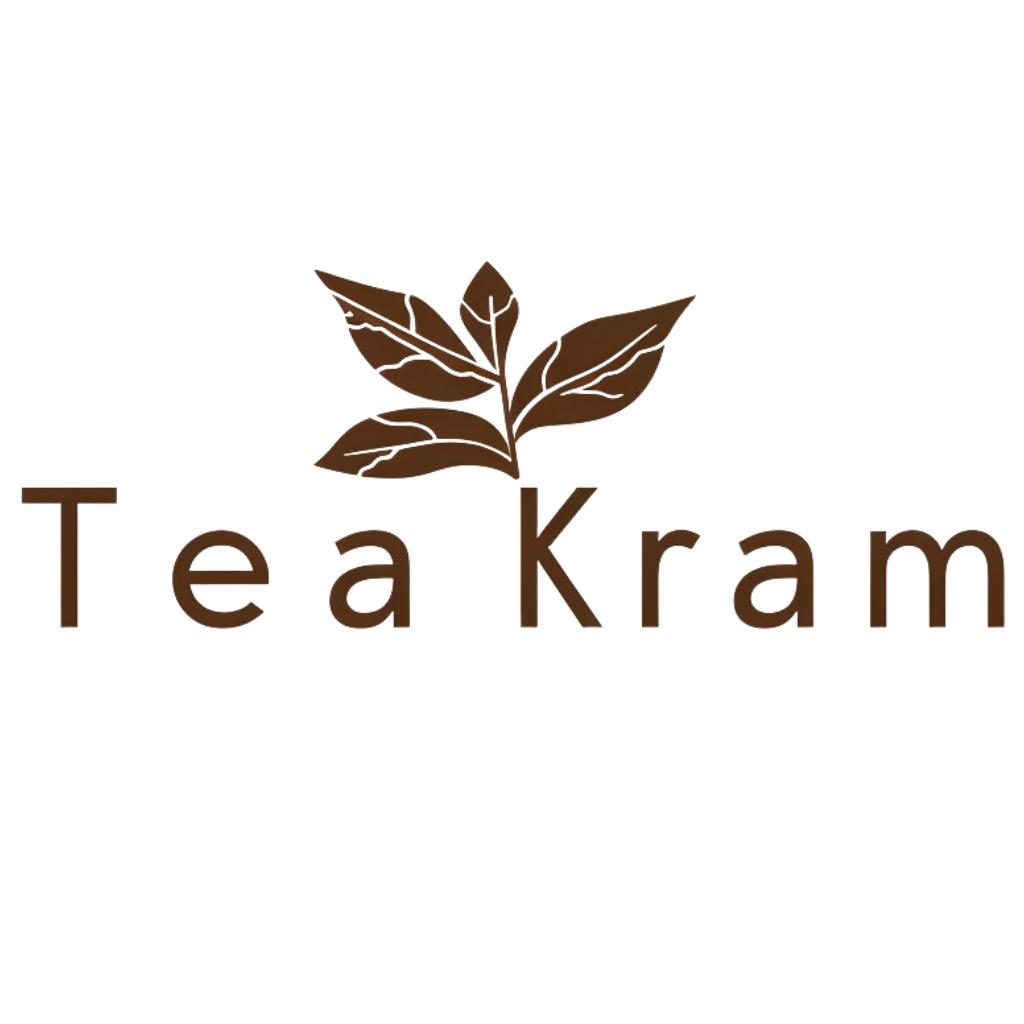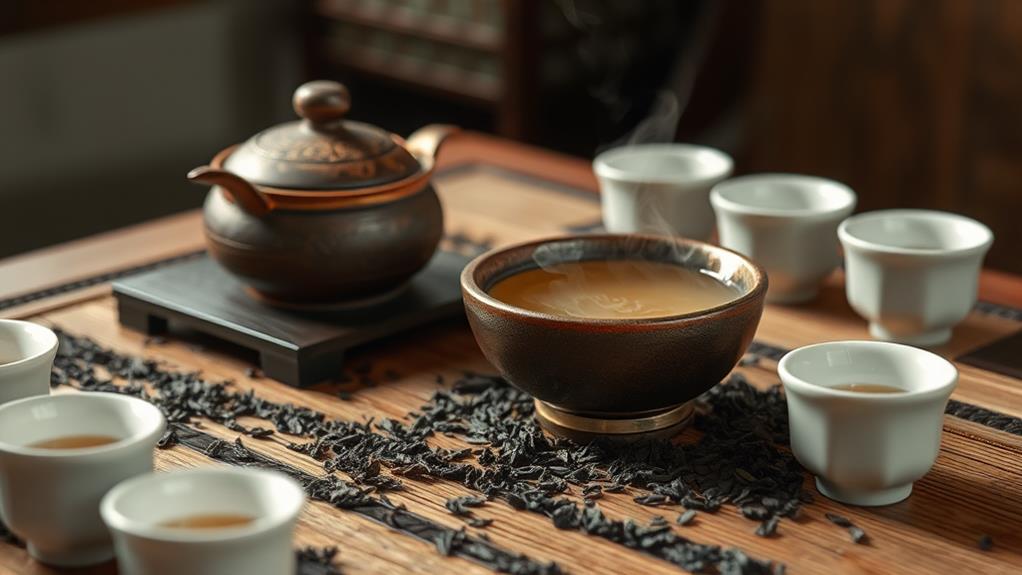A gai wan is a traditional Chinese tea vessel that consists of a bowl, a lid, and a saucer. It's designed to improve your tea experience by allowing you to control the infusion time and temperature. You'll find that its wide bowl helps the tea leaves expand, while the lid keeps the heat in, making your brew flavorful. Originating from the Song Dynasty, the gai wan is practical and elegant, symbolizing a connection between tea culture past and present. With some practice, you can easily master different types of tea, and there's much more to discover about this charming tool ahead!
Definition of Gai Wan
A gai wan is a traditional Chinese tea vessel that combines elegance with functionality. This unique piece is made up of three components: a bowl, a lid, and a saucer. When you hold a gai wan, you can't help but admire its aesthetics. The smooth lines and often intricate designs reflect the artistry of Chinese culture, making it not just a tool but a beautiful object to display.
Beyond its looks, a gai wan carries deeper symbolism. It represents harmony and balance, as it allows you to brew, steep, and sip tea all in one vessel. This simplicity encourages mindfulness during the tea-drinking experience, inviting you to appreciate each moment.
Using a gai wan also enhances your tea-making skills. You can control the infusion time and temperature, leading to a more personalized flavor profile.
Whether you're a tea novice or a seasoned enthusiast, the gai wan's versatility makes it an innovative choice for exploring different teas.
History and Origins
Tracing back to the Song Dynasty (960-1279), the gai wan emerged as a response to the growing appreciation for tea culture in China. This period marked a significant shift in how tea was enjoyed, leading to innovations in tea brewing methods. Gai wan history is rich and fascinating, reflecting a time when tea drinking became an art form.
Initially, these beautiful vessels were designed for practicality, allowing tea lovers to brew and sip with ease. The gai wan's origins can be traced to the need for a convenient way to steep and serve tea, enhancing the overall experience.
As tea culture evolved, so did the gai wan, becoming a symbol of refinement and sophistication. You'll find that the gai wan isn't just a tool; it's a bridge connecting past traditions to modern practices.
Today, it's embraced by tea enthusiasts worldwide, who appreciate both its function and beauty. By using a gai wan, you're participating in a centuries-old tradition, making each cup of tea a moment to cherish.
Design and Components
The gai wan's design reflects both its practicality and aesthetic appeal, making it a favored choice among tea aficionados. With a simple yet elegant structure, the gai wan enhances your tea experience. Its components work together beautifully, showcasing innovative gai wan materials that add character and flair.
Here's what you'll find in a typical gai wan:
- Bowl: This is where you steep the tea. It's generally wide and shallow, promoting even infusion.
- Lid: The lid helps control the brewing process. You can use it to keep the heat in or pour out tea.
- Saucer: This holds the bowl, protecting your surfaces from heat. It often features intricate designs, enhancing gai wan aesthetics.
- Spout: Some gai wans have a small opening for easy pouring, allowing you to serve tea with style.
Whether you choose porcelain, glass, or clay, each material contributes to the gai wan's beauty and function.
The combination of these elements not only serves a practical purpose but also turns your tea ritual into a visually stunning experience. Embrace the innovation and artistry in every sip!
How to Use a Gai Wan
Using a gai wan can elevate your tea brewing experience, allowing you to appreciate the nuances of different teas.
To get started, choose your favorite loose-leaf tea and place about one tablespoon in the gai wan. Next, pour hot water over the leaves, filling the vessel to about three-quarters full. This is where gai wan techniques shine; you can experiment with water temperatures and steeping times for innovative results.
Once your tea has steeped for the desired time, hold the lid slightly ajar and pour the tea into a cup, letting the lid act as a strainer. This step is crucial in a tea ceremony, where precision and care enhance the ritual.
After your first infusion, you can repeat the process, adjusting steeping times to explore different flavors. Remember, each infusion reveals new layers of taste, making your gai wan experience unique.
As you continue your journey, don't hesitate to invite friends to join your tea ceremony. Sharing this innovative brewing method can spark delightful conversations and deepen your appreciation for tea.
Enjoy the process, and let each cup tell its story!
Benefits of Using a Gai Wan
A gai wan offers a wealth of benefits that can transform your tea experience. This traditional tea vessel not only looks elegant but also enhances your brewing process in several ways.
Here are four key benefits you'll enjoy:
- Flavor Enhancement: The gai wan's design allows for better heat retention, which helps to extract the full range of flavors from your tea leaves, giving you a richer tasting experience.
- Health Benefits: Brewing tea in a gai wan can maximize the health properties of your tea, allowing you to enjoy antioxidants and other beneficial compounds more effectively.
- Versatility: You can brew various types of tea in a gai wan, making it a fantastic choice for both beginners and seasoned tea enthusiasts.
- Control: It gives you greater control over steeping times and water temperature, letting you experiment and discover your perfect brew.
Using a gai wan not only elevates your tea-drinking ritual but also invites innovation into your daily routine.
Types of Teas for Gai Wan
When it comes to using a Gai Wan, the type of tea you choose can really make a difference in your experience.
Green tea, known for its health benefits, offers a refreshing taste that's rich in antioxidants.
Oolong brings its unique brewing techniques to the table, providing a delightful complexity to each cup.
And don't forget about pu-erh, which has rich flavor profiles that can surprise even the most seasoned tea drinkers!
Green Tea Selection
Selecting the right green tea for your gai wan can significantly enhance your brewing experience. With so many green tea varieties available, it's important to choose ones that suit your taste and preferred brewing temperatures.
Matcha, for instance, offers a unique flavor profile and health benefits, making it a fantastic choice for those looking to explore health benefits of matcha. Here are four exciting options to consider:
- Sencha: This popular Japanese tea offers a refreshing taste, with a bright green color. Brew it at around 160-180°F for the best flavor.
- Dragon Well (Longjing): This Chinese tea has a nutty, slightly sweet profile. Use lower temperatures, around 175°F, to avoid bitterness.
- Gyokuro: Known for its rich umami flavor, Gyokuro thrives in cooler water, around 140-160°F, allowing its complex flavors to shine.
- Matcha: If you're feeling adventurous, try matcha! This powdered green tea mixes directly with water, giving you a frothy, vibrant drink. Use water around 160°F for a smooth experience.
Experimenting with these green tea varieties and their unique brewing temperatures can lead to delightful discoveries.
Oolong Brewing Techniques
How can you elevate your oolong tea experience with a gai wan? Using a gai wan for oolong steeping brings out the tea's unique flavors like no other method. This traditional Chinese brewing vessel lets you control the infusion time and temperature, maximizing flavor extraction.
Additionally, oolong tea is known for its ability to aid in weight loss and improve digestion, making it a great choice for health-conscious tea lovers each tea type offers unique health properties.
Begin by warming your gai wan with hot water, then add your oolong leaves—about 5 grams for every 100 ml of water is a good rule.
Pour in water just below boiling, typically around 195°F (90°C), and steep for about 30 seconds. With each infusion, gradually increase the steeping time to unveil deeper flavors. Oolong tea is known for its complexity, and a gai wan allows you to explore the tea's evolving taste profile with each pour.
Don't forget to swirl the gai wan gently; this action helps mix the leaves and water, enhancing flavor extraction. You can get multiple infusions from the same leaves, making it an innovative way to enjoy oolong.
Pu-erh Flavor Profiles
Exploring the diverse flavor profiles of pu-erh tea can be a rewarding experience, especially when using a gai wan.
The unique characteristics of pu-erh come from its aging process and the specific terroir where it's grown.
Here's a quick guide to some common pu-erh flavor profiles you might encounter:
- Earthy: Many aged pu-erh teas have a deep, rich earthiness that can remind you of damp forest floors or aged wood.
- Fruity: Some younger pu-erh varieties may surprise you with hints of ripe fruits, like cherries or plums, showcasing their freshness.
- Floral: A few pu-erh teas boast delicate floral notes, creating a fragrant experience that can be reminiscent of jasmine or lilac.
- Spicy: You might also discover a spicy kick, featuring warm notes like cinnamon or clove that add complexity to your cup.
As you experiment with different pu-erh teas, pay attention to how aging and terroir influence the flavors.
Each sip can reveal a new layer, making your gai wan sessions not just enjoyable but truly innovative!
Care and Maintenance
Caring for your gai wan is essential to ensure its longevity and maintain the quality of your tea experience. First, let's talk about cleaning techniques. After each use, rinse your gai wan with warm water to remove any tea residue. Avoid using soap, as it can leave unwanted flavors. For deeper cleaning, soak it in warm water for a bit and gently scrub with a soft cloth or sponge.
When it comes to storage tips, keep your gai wan in a cool, dry place. Avoid stacking it with heavy items, as this can lead to cracks. You might also consider wrapping it in a soft cloth or storing it in a padded box to protect it from bumps and scratches.
Lastly, be mindful of temperature changes—extreme shifts can cause your gai wan to crack. If you're feeling adventurous, try experimenting with different teas to see how they interact with your gai wan over time. This won't only enhance your brewing experience but also give you insight into the care your gai wan needs.
With just a little love and attention, your gai wan can serve you well for years to come!
FAQ
Can a Gai Wan Be Used for Other Beverages Besides Tea?
Absolutely! A gai wan's versatility lets you experiment with alternative beverages like herbal infusions or even cold brews. You'll discover new flavors and experiences, turning your gai wan into a unique tool for creativity.
How Does a Gai Wan Compare to a Teapot?
When you compare a gai wan to a teapot, you'll find the gai wan's history offers a unique brewing experience. Its benefits include precision and versatility, making it perfect for innovative tea enjoyment.
What Is the Best Material for a Gai Wan?
When choosing gai wan materials, consider porcelain for its heat retention and flavor neutrality, or Yixing clay for a unique aging effect. Both have rich gai wan history, enhancing your innovative tea experience in exciting ways.
Are Gai Wans Suitable for Brewing Herbal Teas?
Absolutely, gai wans are fantastic for brewing herbal infusions! You can experiment with various brewing techniques to enhance flavors, allowing you to enjoy innovative herbal blends that cater to your unique palate and preferences.
Can Beginners Successfully Use a Gai Wan?
Absolutely! You can master a gai wan, just like Sarah did when she brewed her first green tea. Its benefits include extracting nuanced flavors and enhancing brewing techniques, making it an exciting tool for any beginner.
Final Thoughts
In summary, a gai wan's graceful design and practical purpose make it a fantastic tool for tea enthusiasts. Whether you're sipping solo or sharing with friends, this versatile vessel can enhance your tea experience. With its rich history and simple use, it's a perfect choice for brewing various teas. So, why not give a gai wan a go? You'll discover delightful flavors and a charming connection to tea traditions that truly tantalize your taste buds!



